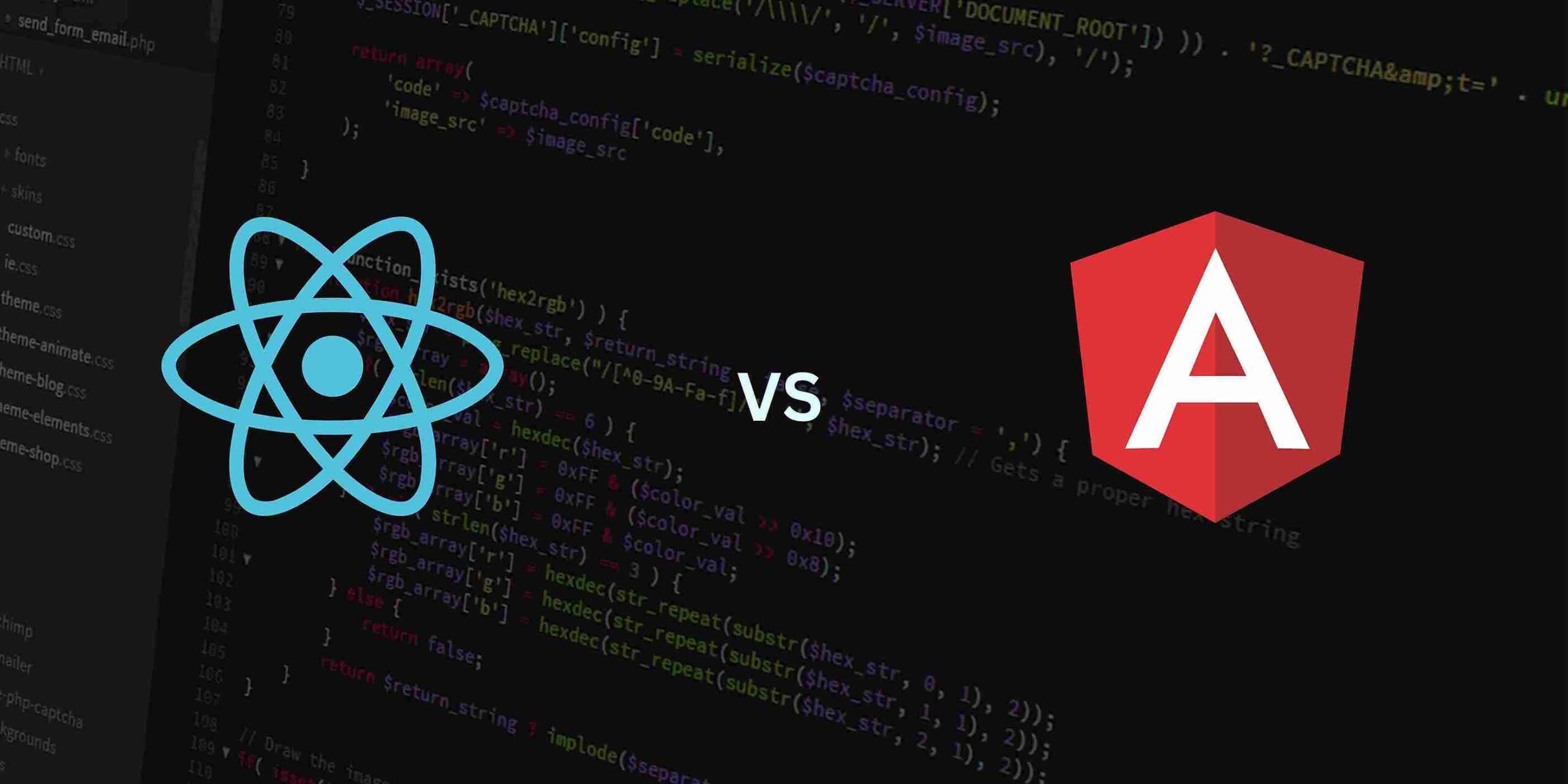Choosing the right framework for your web development project can be a challenging decision, especially when the contenders are as robust and popular as Angular and React. Both frameworks offer unique benefits and have their own sets of strengths and weaknesses. In this comprehensive guide, we’ll explore the core differences between Angular and React, provide a detailed side-by-side comparison, delve into an in-depth analysis, and offer guidance on selecting the right framework for your project. We’ll also highlight some of the big names using these frameworks and conclude with a summary of the key points to help you make an informed decision in 2024.
Understanding the Core Differences Between Angular and React with Benefits
Two of the most widely used frameworks for creating contemporary web apps are Angular and React. Understanding their core differences can help you decide which one is more suitable for your project.
Angular
Angular is a full-fledged framework developed and maintained by Google. It was first released in 2010 as AngularJS and later rebranded as Angular with a complete rewrite in 2016. Angular provides a comprehensive solution with a well-defined structure, making it an excellent choice for large-scale applications.
Benefits of Angular:
- Two-Way Data Binding: Angular’s two-way data binding automatically synchronizes the data between the model and the view, reducing the amount of boilerplate code.
- Comprehensive Framework: Angular includes everything needed for building complex applications, including tools for routing, state management, form validation, and more.
- Dependency Injection: Angular’s built-in dependency injection simplifies the development process and enhances code reusability.
- Strong Community and Support: Backed by Google, Angular has a large community and extensive documentation, making it easier to find solutions and get support.
- TypeScript: Angular is built with TypeScript, offering static typing, improved tooling, and better code maintainability.
React
React is a JavaScript library developed and maintained by Facebook. It was first released in 2013 and focuses primarily on building user interfaces. React’s component-based architecture makes it highly flexible and easy to integrate with other libraries or frameworks.
Benefits of React:
- Virtual DOM: React’s virtual DOM efficiently updates and renders components, resulting in high performance.
- Component-Based Architecture: React encourages the creation of reusable components, enhancing code maintainability and scalability.
- One-Way Data Binding: React’s one-way data binding provides better control over data flow, making it easier to debug and test.
- Flexibility: React may be used with a wide range of other frameworks and libraries, giving developers the freedom to select the ideal solutions for their particular requirements.
- React Native: React’s ecosystem includes React Native, enabling the development of mobile applications using the same principles and components as web applications.
Quick Comparison: Angular vs React
To better understand the differences between Angular and React, let’s compare them in a tabular form across various aspects:
| Aspect | Angular | React |
| Type | Framework | Library |
| Developed By | ||
| First Release | 2010 (as AngularJS), 2016 (as Angular) | 2013 |
| Language | TypeScript | JavaScript |
| Architecture | MVC (Model-View-Controller) | Component-Based |
| Data Binding | Two-Way Data Binding | One-Way Data Binding |
| DOM | Regular DOM | Virtual DOM |
| Learning Curve | Steeper, due to its complexity | Moderate, simpler to get started |
| Size | Larger | Smaller |
| Community Support | Strong, backed by Google | Strong, backed by Facebook |
| Ecosystem | Complete solution with built-in tools | Flexible, can be integrated with other libraries |
| Mobile Development | NativeScript, Ionic | React Native |
Angular vs React: Comprehensive Analysis
Learning Curve
Angular: The learning curve for Angular is steeper compared to React. Angular is a full-fledged framework that requires understanding concepts like dependency injection, decorators, and TypeScript. However, once mastered, Angular provides a structured and consistent development experience.
React: React is easier to learn, especially for developers familiar with JavaScript. Its component-based architecture is intuitive, and developers can gradually introduce additional tools and libraries as needed. React’s simplicity makes it an excellent choice for beginners and smaller projects.
Performance
Angular: Angular’s two-way data binding can sometimes lead to performance bottlenecks in large applications. However, Angular’s change detection mechanism has improved over the years, and it offers tools like Angular Universal for server-side rendering to boost performance.
React: React’s virtual DOM ensures high performance by minimizing direct DOM manipulations. React’s reconciliation algorithm efficiently updates the UI, making it faster for dynamic and complex interfaces. React’s performance is generally superior, especially for large-scale applications with frequent updates.
Flexibility and Ecosystem
Angular: Angular is a complete framework that includes everything needed for building web applications. While this reduces the need to find and integrate third-party libraries, it also means less flexibility. The conventions and patterns of Angular must be followed by developers.
React: React is highly flexible and can be used with various other libraries and frameworks. This modularity allows developers to choose the best tools for their specific needs. React’s ecosystem is vast, with many third-party libraries available for routing, state management, and more.
Community and Support
Angular: Backed by Google, Angular has a strong community and extensive documentation. Regular updates and a well-maintained ecosystem ensure long-term support and stability.
React: React is backed by Facebook and has a large, active community. The React ecosystem is continuously evolving, with a wealth of resources, tutorials, and third-party libraries available.
Use Cases
Angular: Angular is ideal for large-scale enterprise applications that require a comprehensive framework. Its structured approach and built-in tools make it suitable for complex projects with extensive requirements.
React: React is well-suited for a wide range of applications, from small projects to large-scale applications. Its flexibility and performance make it a popular choice for interactive user interfaces, SPAs (single-page applications), and mobile applications using React Native.
Selecting the Right Framework for Your Project
Choosing between Angular and React depends on various factors, including the project’s requirements, team expertise, and long-term goals.
When to Choose Angular
- Large-Scale Enterprise Applications: Angular’s comprehensive framework and built-in tools make it an excellent choice for large, complex applications.
- TypeScript Preference: If your team prefers TypeScript for its static typing and advanced tooling, Angular is the right choice.
- Structured Development: Angular’s opinionated structure and conventions provide a consistent development experience, which is beneficial for large teams and long-term projects.
When to Choose React
- High Performance: If your project requires high performance and frequent updates, React’s virtual DOM and efficient rendering make it a superior choice.
- Flexibility and Modularity: React’s flexibility allows you to choose the best tools and libraries for your specific needs, making it ideal for projects with evolving requirements.
- Mobile Development: If you plan to develop both web and mobile applications, React Native allows you to leverage the same principles and components across platforms.
- Faster Time-to-Market: React’s simplicity and ease of integration with other libraries can accelerate development, making it suitable for projects with tight deadlines.
Big Names Using React and Angular for Their Projects
Companies Using Angular
- Google: Angular is developed and maintained by Google, and many of Google’s internal applications use Angular.
- Microsoft: Microsoft uses Angular for various web applications, including the Azure platform.
- Forbes: Forbes has built its website using Angular, leveraging its performance and scalability.
- BMW: BMW’s official website uses Angular for its dynamic and interactive features.
Companies Using React
- Facebook: React is developed and maintained by Facebook, and it is extensively used across Facebook’s applications, including Instagram and WhatsApp.
- Netflix: Netflix uses React for its high-performance user interfaces and dynamic content.
- Airbnb: Airbnb leverages React for its rich, interactive user experiences and seamless performance.
- Uber: Uber uses React for its web applications, focusing on efficient rendering and high performance.
Conclusion
Choosing between Angular and React in 2024 depends on your project’s specific needs and goals. Angular offers a comprehensive framework with a structured approach, making it ideal for large-scale enterprise applications. React provides flexibility, high performance, and a component-based architecture, making it suitable for a wide range of projects, including those requiring rapid development and mobile applications.
Both frameworks have strong community support and are backed by tech giants, ensuring long-term viability and continuous improvements. By understanding the core differences, benefits, and use cases of Angular and React, you can make an informed decision that aligns with your project’s requirements and your team’s expertise. Whether you choose Angular or React, both frameworks are powerful tools that can help you build robust and modern web applications.



